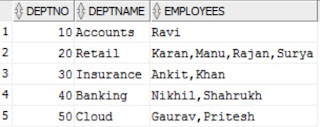What are the different ways we can combine column values as Comma
Separated Values in Oracle & SQL?
Oracle has introduced
the aggregate function LISTAGG to get Comma separated values based on the
Grouping Column.
Let’s say you
have following Tables and you want Comma separated Employees List for each
department as DEPTNO, DEPTNAME, EMPLOYEES
SQL> SELECT * From EMP_TEST;
EMP_NO ENAME DEPTNO HIREDATE
---------- ---------- ---------- ---------
1001 Ravi 10 19-AUG-16
1002 Surya 20 26-DEC-16
1003 Ankit 30 12-DEC-16
1004 Nikhil 40 12-DEC-10
1005 Pritesh 50 19-AUG-16
1006 Rajan 20 16-AUG-10
1007 Manu 20 16-AUG-10
1008 Karan 20 16-AUG-10
1009 Gaurav 50 19-MAR-17
1010 Shahrukh 40 11-MAR-17
1011 Khan 30 11-MAR-16
11 rows selected.
SQL> SELECT * From DEPT_TEST;
DEPTNO DEPTNAME
---------- --------------------
10 Accounts
20 Retail
30 Insurance
40 Banking
50 Cloud
***Using LISTAGG:
SELECT E.DEPTNO, D.DEPTNAME,
LISTAGG(ENAME, ',') WITHIN GROUP (Order By ENAME) "EMPLOYEES"
From EMP_TEST E, DEPT_TEST D
Where E.DEPTNO=D.DEPTNO
Group By E.DEPTNO,D.DEPTNAME;
OUTPUT
***Using User Defined Function:
Before LISTAGG
was introduced, we used to do this with User Defined Function. Let’s try that.
Purpose: All you have to do is to Create a
Function which will Accept Department as an Input and will return List of
Employees working for that Department.
Function Definition:
CREATE OR REPLACE FUNCTION GET_EMPLOYEES_LIST(IN_Deptno IN NUMBER)
RETURN VARCHAR2 IS
CURSOR C1 IS
SELECT Ename FROM EMP_TEST
WHERE Deptno = IN_Deptno
ORDER BY Ename;
l_ret VARCHAR2(2000);
BEGIN
FOR rec IN C1
LOOP
IF C1%ROWCOUNT > 1 THEN
l_ret := l_ret || ', ';
END IF;
l_ret := l_ret || rec.ename;
END LOOP;
RETURN l_ret;
END;
SELECT Query:
SELECT E.DEPTNO, D.DEPTNAME,
GET_EMPLOYEES_LIST(E.DEPTNO) EMPLOYEES
From EMP_TEST E, DEPT_TEST D
Where E.DEPTNO=D.DEPTNO
Group By E.DEPTNO,D.DEPTNAME
ORDER BY E.DEPTNO;
OUTPUT
***Using REF Cursor:
In this case,
we will first Define a REF Cursor which then will be passed to a Function to
get the desired Output.
Type:
CREATE OR REPLACE PACKAGE MyPackage IS
TYPE Ref_Type IS REF CURSOR;
END MyPackage;
END MyPackage;
Function Definition:
CREATE OR REPLACE FUNCTION EMPLOYEES_LIST(In_refcur IN MyPackage.Ref_Type)
RETURN VARCHAR2 IS
l_string VARCHAR2(2000);
l_ret VARCHAR2(2000);
BEGIN
LOOP
FETCH in_refcur INTO l_string;
EXIT WHEN in_refcur%NOTFOUND;
IF in_refcur%ROWCOUNT > 1 THEN
l_ret := l_ret || ', ';
END IF;
l_ret := l_ret || l_string;
END LOOP;
CLOSE in_refcur;
RETURN l_ret;
END;
SELECT Query:
SELECT D.DEPTNO, D.DEPTNAME,
EMPLOYEES_LIST(CURSOR(SELECT Ename FROM
EMP_TEST E
WHERE E.Deptno = D.deptno ORDER BY Ename))
EMPLOYEES
FROM DEPT_TEST D
ORDER BY D.Deptno;
***Using COLLECTIONS:
In this case, we
will be creating a COLLECTION type and then passing that Type to a Function to
get the desired output.
COLLECTION Type:
CREATE OR REPLACE TYPE MyType IS TABLE OF
VARCHAR2(2000);
Function
Definition:
CREATE OR REPLACE FUNCTION GET_EMP_LIST(In_strings IN MyType)
RETURN VARCHAR2 IS
l_ret VARCHAR2(2000);
BEGIN
IF In_strings.COUNT > 0 THEN
FOR i IN 1 .. in_strings.COUNT
LOOP
IF i > 1 THEN
l_ret := l_ret || ', ';
END IF;
l_ret := l_ret || in_strings(i);
END LOOP;
END IF;
RETURN l_ret;
END;
SELECT Query:
SELECT D.Deptno, D.Deptname,
GET_EMP_LIST(CAST(MULTISET(SELECT Ename
FROM EMP_TEST E
WHERE E.Deptno = D.Deptno
ORDER BY Ename
) AS MyType
)
) AS EMPLOYEES
FROM DEPT_TEST D
ORDER BY D.deptno;
Get involved and leave your Comments in the Box Below. The more people get involved, the more we all benefit. So, leave your thoughts before you leave the page


Which technique will perform faster . can you tell me ?
ReplyDeleteEverything else works slower than LISTAGG(of course) but serves the purpose.
DeleteNice blog, Thanks For Sharing this informative Article.
ReplyDeleteOracle Fusion SCM Online Training
Oracle Fusion Financials Online Training
Actually very good website to learn. but most of links not working
ReplyDeleteplease check ur links.
for eg:- if i click on Collection and Collection types. it shows error as this sites can't b reached.